I park in Parton, duck under the railway line, and find the shore. This is Parton Bay and I think there might be a sandy beach here when the tide is low.
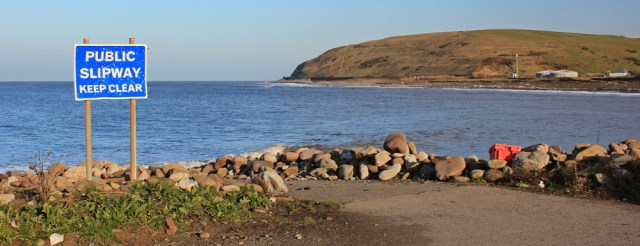
This morning the tide is high and the sand is covered. But I’m not alone. There are families with children walking about. Unusual, because it’s a school day. [Later, on the news, I learn the local teachers were on strike.]
I avoid taking identifiable photos of children, for obvious reasons, so I take some shots of the waves and seagulls instead.

My walk along the shore soon comes to an end when the new England Coast Path takes me back under the railway line, and inland.

At least the path is clearly marked. But, again, I’m convinced they need to design a more evocative and distinctive logo for this important new National Trail.
I follow a quiet road and climb a hill (Stamford Hill – the same name as my home town!), before the path branches off to the right. It takes me around a weird-looking headland, carved like a giant helter-skelter that’s been squashed downwards. It must be an old quarry. Or slag heap. Definitely not natural. 
On the way up I pass an informal memorial. You find many of these nowadays. Sometimes they mark the sites of fatal accidents, or suicides. Sometimes, perhaps, they mark places where ashes have been scattered.
This one is for John Oliver, who died in 2006. It’s decorated by a statue of a bird, strings of beads, and plastic roses.
It seems that traditional burial places no longer offer the same feeling of commemoration. I used to find these memorial shrines maudlin, but now I find them reassuring. They’re both symbols of our mortality and our immortality too.
Onwards, I work my way up and around the headland. Lowca Point.
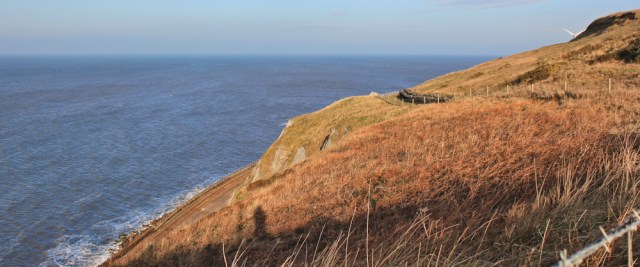
At the top is a strange mix of grassland, old concrete standings, decaying walls, and piles of bricks. I strike up a conversation with a dog walker. He tells me this used to be an industrial area, then became farmland, and now is taken up mainly by a wind farm. We can see their sails just below us.

I’ve just done an excellent MOOC course called The Art of Photography on the Australian site, Open2Study, and so I hang around taking photographs of piles of bricks, which I hope will look artistic, but I suspect end up looking just look like piles of bricks!
 My local guide has two lovely springer spaniels. Like all spaniels, they are obsessed with fetching things. This one brings me sticks in the hope I’ll throw them. Then, fed up with my apparent disinterest in sticks, finds me a plastic bottle.
My local guide has two lovely springer spaniels. Like all spaniels, they are obsessed with fetching things. This one brings me sticks in the hope I’ll throw them. Then, fed up with my apparent disinterest in sticks, finds me a plastic bottle.
Eventually, they leave and I get on with my task of taking moody photos of bricks.

But my photography is rudely interrupted by another dog.
This one isn’t so friendly, and makes aggressive rushes towards me, barking loudly. I’m glad I have my walking pole. Eventually his owner, who is at least 100 yards away, manages to call him off.
This dog never actually gets closer than 10 feet or so, but it’s another unnerving experience with an out-of-control dog. (A month ago I was bitten by a farmyard collie while walking down a public bridleway in Lincolnshire.)
I decide to stop messing about with bricks, and get on with my walk.
The England Coast Path in this area is only 22 miles long, but the route is still incomplete, as this sign warns me. The next stretch runs further away from the coast. Shame.

So, a last photo of bricks… this one features me in the background! Then I’m off…

… along a track where some bold sheep make a stand. And only move at the last minute.

A few minutes later I meet my friendly dog-walker returning. The springer spaniels are still springing about, full of energy, and bring me more sticks. But I can’t stop and play – sorry – because I’ve got to get on with my walk.
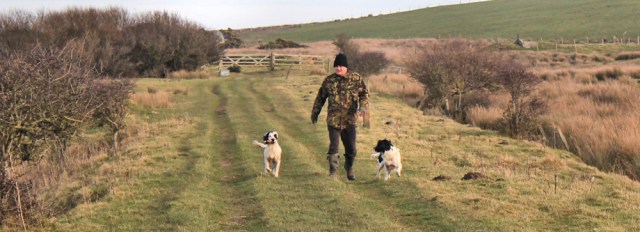
I’m following the edge of the wind farm. The final route of the path will be on the seaward side of the turbines. But, for now, I’m on the landward side.
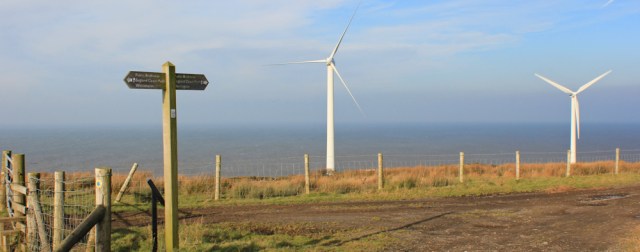
Still, it’s a pleasant walk along an easy track. And, as I come over the brow of the headland, I can see Workington ahead.

Looks like people have been taking advantage of the track to do some fly tipping. Either they, or the long-suffering farmer, have made an attempt at burning the rubbish. Shame. Rather an eyesore.
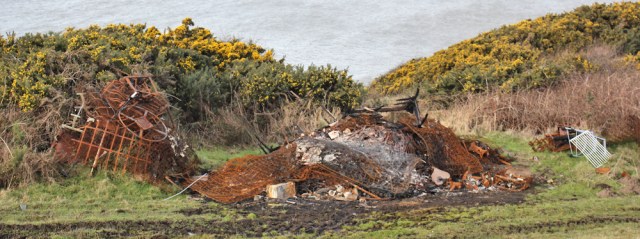
Mind you, the farmer seems equally messy, with odd collections of decaying machinery littering the landscape too. In the distance is another decaying structure: a pillbox.

I’m approaching Harrington, a coastal village just south of Workington. Despite the fact the sea isn’t very rough today, I can see great waves splashing over the harbour wall.
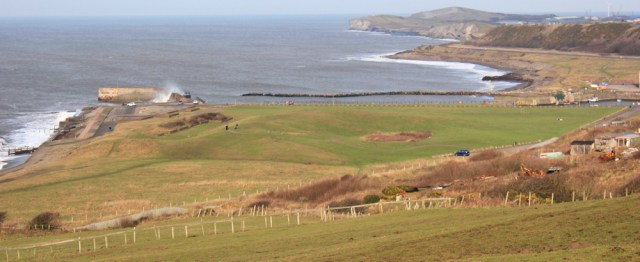
Harrington is a pretty place. There’s a little marina – with very few boats – and a nice public green space, with an interesting statue of a man holding a large fish. A fisherman? The fish appears to be getting its own back by eating the man’s hand.
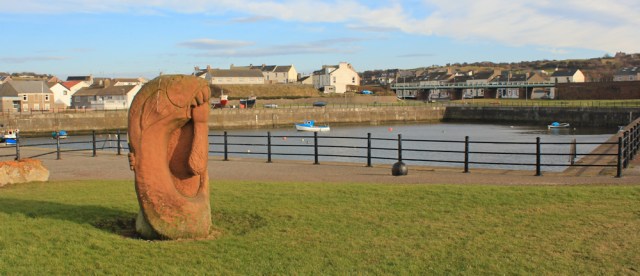
Some sort of information plaque would have been helpful. Later, I learn:
- The green space was once the site of a secret magnesium plant, which extracted magnesium from seawater during WW2 to fuel incendiary bombs.
- The sculpture is called ‘Sea Legend’, by the sculpture Shawn Williamson who lives in Cumbria.
The only sign I see, at the time, is a warning about danger of death if I get close to the sea wall.
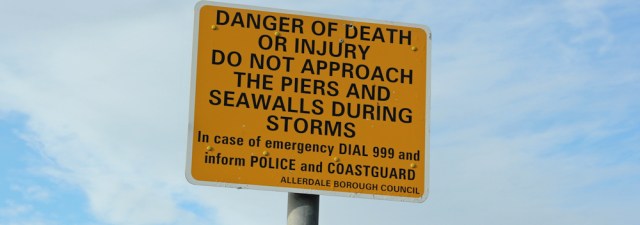
And this is why! Despite the sea not being particularly rough today, the waves slap up and lash over the outer wall of the harbour. I would love to see it in a real storm.

I look over the bay at the next headland of low-lying land. After a quick drink and snack I press onwards, towards Workington.
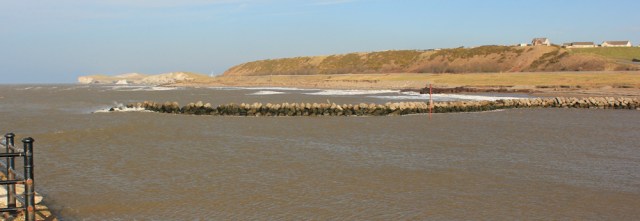
I follow a clear footpath which runs close to the shore. Some interesting conical structures catch my attention. They look like rounded beehives. Weird. In the end, I decide they must be made of aggregated materials, moulded into these distinctive shapes (why?) and placed along the shore to prevent erosion.
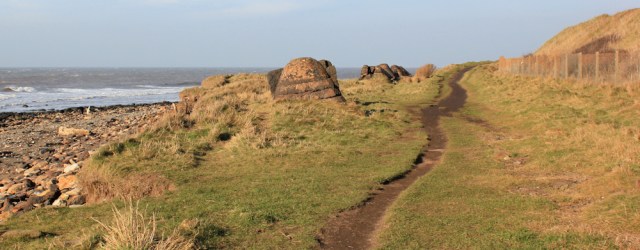
Of course, they may have another function, or be left over from past industry, but I couldn’t think of another explanation.
To my right is the railway line, with the occasional train rumbling by. And from Harrington onwards, the land on the other side of the railway becomes increasingly urbanised, with houses peering over the ridge.
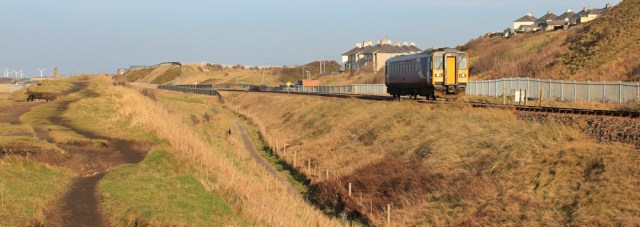
Ahead are some chalky cliffs. I am looking forward to walking over them. In the photo below, you can see the conical structures have grown in number and continue to line the shore, making walking along the beach impossible.

But I discover I can’t walk across the cliffs after all, because a giant quarry lies in the way. (For a moment I’m tempted to ignore the signs and carry on, something that other people have clearly done before me. But I suspect I would only come to a dead-end.)
I decide to stick to the official England Coast Path, and head down to cross under the railway.
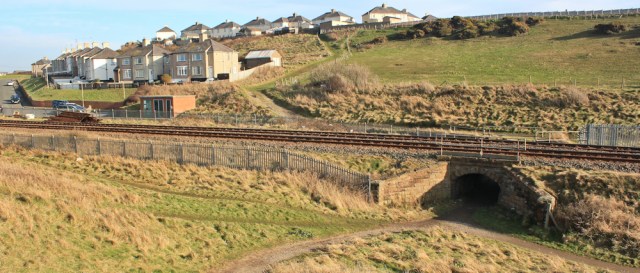
From here onwards the path is far from scenic. High fences. Quarries and industry to my left. Housing estates to my right.

Further on and the houses give way to industrial yards. Or, more accurately, industrial wasteland. Actually, I quite enjoy this bit and take plenty of ‘artistic’ photographs. I like looking at interesting industrial scenery, especially where everything is weathered, rusting and neglected.
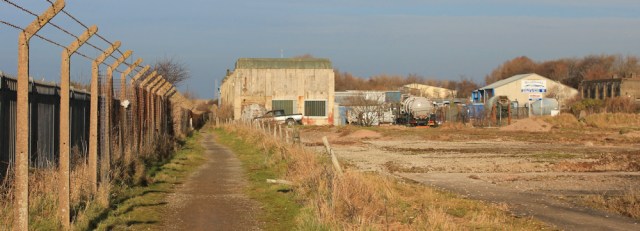
After a couple of miles of this, I emerge onto a road. Always a shock, after hours of walking on my own, to find I’m in the middle of a town!

This is the outskirts of Worthington. I walk through an industrial estate, and am grateful for the England Coast Path signs, because otherwise I’m sure I would get lost. Then I climb up a green area of common land (perhaps the site of an old quarry) and find myself high on a cliff overlooking the sea.

Below are quarry workings. I’m always torn between dismay at the scarred scenery, and excitement at seeing the new and interesting shapes carved into the landscape. Quarrying is like sculpting, but on a giant scale and with random results.

To my right is Workington. And, in the distance, the blue humps of the Cumbrian hills.

It’s been a day for signs. Here is one warning me, somewhat unnecessarily, of the dangerous cliff to my left.
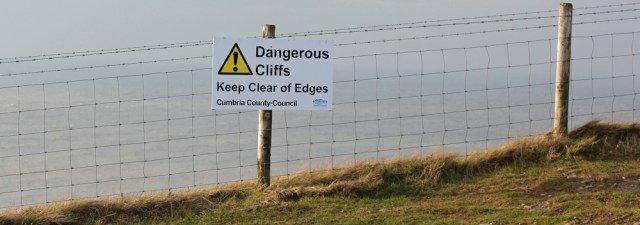
At the highest point on the cliff is a cross. Not just the shape of a cross, but a cross with a figure hanging from it. It’s something you see commonly on the continent, but not so often in England.

[Later I learn the cross was erected unofficially in 2015 by Peter Nelson as a memorial to his wife. After some controversy and debate, it’s been allowed to remain in place. Here’s a link to the BBC news item.]
From here onwards the path heads downhill. Ahead is a small lighthouse and a breakwater. They guard the mouth of the River Derwent, and the entrance to Workington’s harbour.

But before I go down, I take several photographs of the landscape on the other side of the river. It’s another wind farm, with industrial complex beyond. Unfortunately, the camera can’t capture the elegance of the slowly turning turbines. Anyway, in the slanting light of the afternoon sun, I think it looks beautiful.

Down by the lighthouse is a small car park and a number of dog walkers.

I walk to the end of the breakwater – ignoring the warning signs – and sit on a piece of concrete. Time for a rest and a quick snack.

After that, it’s time to head inland, following the Derwent into the heart of Workington, along a rather soulless promenade.

The light is fading quickly now. But I discover a small marina tucked along the bank of the river, and it looks beautiful in the mellow light. The tide is out, and I love the rippled patterns in the mud.

I was intending to walk on to Flimby, but the sun is sinking low and I decide it’s time to find the station and catch the train back Parton.
It’s been a slow and unusual walk today. A mix of rural and industrial landscapes, full of signs and symbols, and with plenty of interesting things to look at.
A selection of my ‘arty’ photographs taken today can be found on Ruthless Ramblings: Textures and Patterns
Miles walked today = 8.5 miles (yes, my distances really are getting shorter!)
Total distance = 2,959.5 miles
Route:




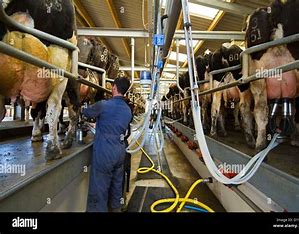
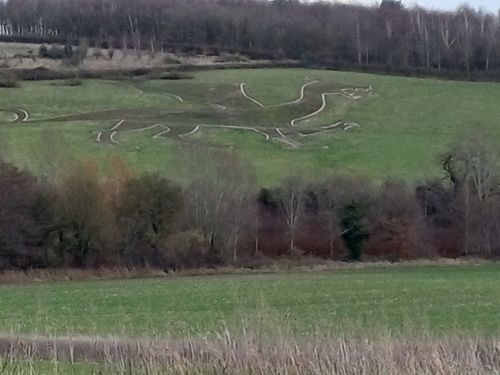
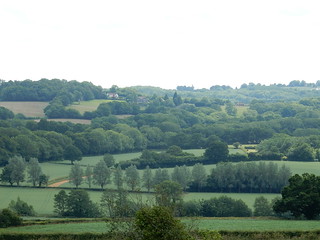
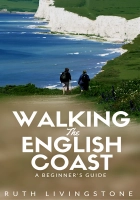
I like your arty pictures! I just started reading recently and am quite enjoying your blog.
Hi Mary and welcome to my blog. Thank you for your kind words about the blog and my photos 😆
Interesting! I like the sheep
Kim
Hi Kim. Sheep are nice creatures. Dim, but basically good natured. Just don’t get me started on cows… 😀
Looks like quite a varied walk. Some nice sections some industrial ones. I’ll be doing this walk in a couple of months so now I know what to expect! It’s nice to see a few more England Coast Path signs about.
I think you’ll enjoy it, Jon. Will probably do twice the mileage 😀 Yes, nice to see some England Coast Path signs – these are the first I’ve come across so far.
Hi Ruth I love you! Your whole walk is inspirational, Weldon xx
Hi Brian and thank you! Best wishes.
Hi Ruth, tokens and memorial items to those lost by family and friends are something that is now commonplace to those who walk along roads, hills and fells. Whether it is a bench seat, a football scarf, prayer flags, ashes or just a simple message I find it rather sad. Especially when that person stood where you are now standing and admired the same stunning and beautiful view. Whenever I take a breather on a bench seat with a dedication, I always read the inscription and thank them. Of course , things can get out of hand, the summit of Ben Nevis is now littered with hundreds of cairns and messages, too many to read and reflect on. Indeed, I have also left a message. Deep within a cairn on a Scottish mountain, well out of reach to the summit visitor, I have placed a bronze plaque with a simple message to my son Matthew, who died in 1998, aged 11 years.
I’m very, very sorry to hear about your son. It must be truly awful to lose a child. I imagine your bronze plaque, placed in a beautiful place, is a loving tribute to his memory.
I’m always aware when I come across these various memorials – and there are so many of them now, as you noted – that each one represents a world of pain and longing. I used to find them rather depressing, as reminders of my own mortality. Now I find them oddly reassuring, as reminders that these people were all loved and treasured, and still live on in other people’s memories.
Memorial items left for way too long annoy me! There are still Christmas decorations faded and tattered on seats around our town, and it’s now mid Feb. Why do people do this? It’s not a good memorial to their loved ones long after the anniversary etc to leave things still in situ, do you find that too on the walks Ruth? Started following you when you walked our area of North Devon…..look how far you’ve travelled since!
Hi Pam. I agree about the need to look after memorials. When I see a bunch of really withered flowers, or even worse, just the cellophane that remains, I feel sad.
Yes, I’ve come a long way, haven’t I. Still a long way to go… Scotland just round the corner.
Great to be ‘walking’ again. Shorter walks mean more posts 🙂 I particularly like your photo of the rocks at Harrington. I’m guessing they are igneous as they still look like flowing lava.
Thank you Jacquie. I enjoy writing up my walks, but always amazed by how much I find to say!
Great to see you back on the paths for 2017! I too share your interest in post-industrial landscapes and I always find it interesting when I visit such places to pore over old OS maps of the area. One invaluable resource I find is from the Sabre web site (a site for enthusiasts of all things road related) which has a maps section http://www.sabre-roads.org.uk/maps . If you select “Historic OS maps” and then something like the 1:25000 series and then zoom in on Parton and Workington for example it’s incredible to see the labyrinth of rail lines that used to support the steel works, mines and quarries where you’ve just walked (as I did in summer 2015) which are now just acres and acres of desolation.
Wow. That’s an amazing resource! Thank you so much, Mike, for posting the link. I love maps – both old and new – and this is fantastic. Yes, it’s incredible to see how much the landscape has changed. I’m now going to spend far too long looking at old maps…
Great blog. It’s interesting reading about your experiences whilst taking on new walks. Walking in the English countryside is always beautiful and captivating. It’s great to breath in the fresh air (even in the brisk winter) and to make the most of the views we have so close to us.
Thank you Jane.
Hi Ruth. the “conocal structures” between parton and harrington are plugs of impurities taken from the bottom of blast furnessses when making steel. The clifs of workington are manmade spoil or slag heaps. To me Fasenating relics from our post industrial history. Had a lady in last week called Anne, Just starting the walk but going anticlockwise. However intending to walk each stage in a clockwise direction! Any tips for her?
Regards
Neil (rosegarth)
Hi Neil and thank you so much for clearing up this mystery. I’ve seen breakwaters made from prefab concrete before, but none made from this weird aggregation of materials or shaped in such a peculiar way. This explains it! Thank you. I agree, fascinating relics.
Anne needs to buy my book 😉
My best tip is just to take it one stage at a time and don’t look too far ahead. As soon as I started walking (in Norfolk) people started asking me how I was going to tackle Scotland! Well, I’m nearly there… and I still don’t know how I’m going to tackle Scotland, but I’m sure it will be fine.
Those structures on the beach remind me of the dragons teeth tank traps around the countryside here. There do seem to be a lot more memorials about these days. Recently there have been a spate of ghost bikes (painted white) popping up where cyclists have been killed.
Nasty and obtrusive dogs spoil any walk with inconsiderate owners, have to gaurd any food as the dogs consider it there’s…it is the biggest problem for me and I love walking, but it is always spoilt by these totally selfish owners and potentially dangerous animals..
Hi Peter. I love dogs and like meeting them on walks, but only if they have an owner who knows how to control them. It’s not only dogs who try to eat your sandwiches – I’ve had trouble with ponies and goats too 😄
I visited Harrington beach this year. I used to live nearby, 70 and later 50 years ago, and it’s both familiar and changed. The conical tank-traps are definitely blast furnace slag, the raised beach on which they were placed having now eroded, leaving them on the beach proper. Around the southern end of them, at low tide, one can find discarded/used Bessemer furnace tuyeres. The picture below the Danger photo was part of a long-gone magnesite works, the “harbour wall” housing what we used to call the sluice – an intake or out-take from the works. By having the luck of a spring tide (at low tide), I was able to walk round it for the first ever time, and see up the long concrete pipe, and the remains of the flap at the end – the sluice, I suppose. This was considered dangerous in my younger days, and I thought it unwise to explore it. Nice pictures, thank you.
Hi John, and thank you for this information. I really liked Harrington, and lucky you for having lived nearby. It was a fascinating landscape and an enjoyable walk.
Pingback: 26. St Bees to Harrington – A 5000 mile walk